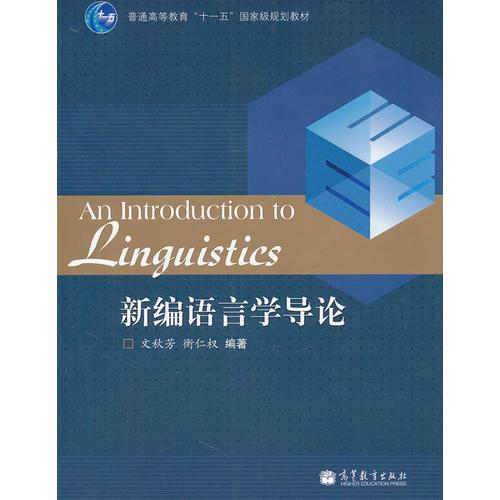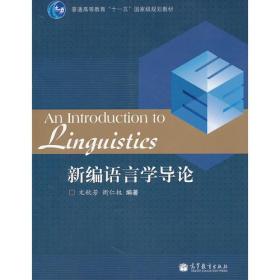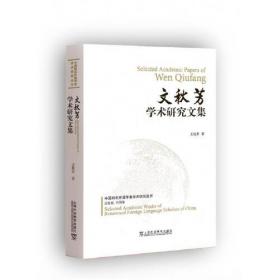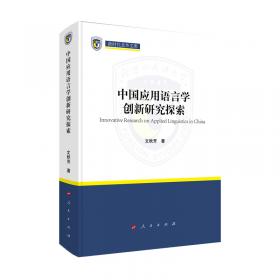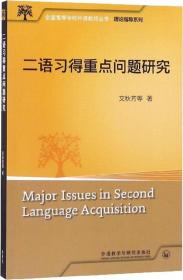新编语言学导论(普通高等教育十一五国家级规划教材)
出版时间:
2011-03
版次:
1
ISBN:
9787040287134
定价:
30.00
装帧:
平装
开本:
16开
纸张:
胶版纸
字数:
323千字
96人买过
-
文秋芳、衡仁权编著的《新编语言学导论》全书分为三部分。第一部分语言体系(Language
system),第二部分语言运用(Language use),第三部分语言学习(Language
learning)。全书用英文撰写,行文流畅。
简明易懂,概念明确,例证丰富。每个章节后面附有总结(Summary)、学习建议(Suggestio for
study)、练习(Questio and exercises)与小型研究课题(Mini—research
project),便于教师组织教学,也方便读者自学。《新编语言学导论》可作为英语专业本科学生的教材,也可作为硕士研究生的辅助读本。
文秋芳:北京外国语大学中国外语教育研究中心主任,教授,博士生导师,中国英语教学研究会会长。1985年获印度孟买大学硕士学位,1993年获香港大学博士学位;曾在南京师范大学和南京大学任教。研究领域为应用语言学,研究兴趣包括二语习得、学习策略、口语测试、语料库研究等。
衡仁权,苏州大学副教授、硕士生导师、博士。近年来在《外语教学与研究》、《外语界》等刊物发表论文多篇;出版专著《英语专业学生口语中动词语法型式使用研究》;参编《英语语法实用教程》,《读写教程》等教材。 Introduction
1 Linguistics and English linguistics
2 Structure of the book
Part I Language System
Overview
Chapter One What Is Language?
1.1 The nature of language
1.1.1 Defininglanguage
1.1.2 The design features of language
1.2 Distinctio between important concept pai in
linguistic study
1.2.1 Synchronic and diachronic
1.2.2 Langue and parole
1.2.3 Competence and performance
1.2.4 Syntagmatic and paradigmatic
Summary
Suggestio for study
Questio and exercises
Mini-research project
ChapterTwo Phonetics
2.1 Speech orga
2.2 Co onants and vowels
2.2.1 The International Phonetic Alphabet
2.2.2 Describing the English co onants
2.2.3 Describing the English vowels
Summary
Suggestio for study
Questio and exercises
Mini-research project
Chapter Three Phonology
3.1 Important concepts in phonology
3.1.1 Phonemes
3.1.2 Minimal pai and sets
3.1.3 Phonemes, phones and allophones
3.2 Identifying phonemes
3.2.1 Environment and distribution
3.2.2 Three types of distribution
3.3 Sequences of phonemes
3.4 Co-articulation effects
3.4.1 Assimilation
3.4.2 Elision
3.5 Supra-segmental features
3.5.1 Stress
3.5.2 Tone and intonation
3.5.3 Juncture
Summary
Suggestio for study
Questio and exercises
Mini-research project
Chapter Four Morphology
4.1 What is morphology?
4.2 Morphemes
4.3 Classificatio of morphemes
4.3.1 Roots and affixes
4.3.2 Free morphemes and bound morphemes
4.3.3 Prefixes, suffixes and infixes
4.3.4 Inflectional and derivational affixes
4.3.5 Root, base, and stem
4.4 Morphemes, morphs and allomorphs
4.5 Empty morph and zero morph
4.6 Morphemic analysis
4.7 The role of morphology in English
4.7.1 Grammatical functio of inflectional
morphology
4.7.2 Derivational morphology and word-formation
processes
Summary
Suggestio for study
Questio and exercises
Mini-research project
Chapter Five Syntax
5.1 Structural description of sentences
5.1.1 Syntactic relatio
5.1.1.1 Sequential (syntagmatic) relatio
5.1.1.2 Substitutional (paradigmatic)
relatio
5.1.1.3 Hierarchical relatio
5.1.2 Labeled IC analysis and the hierarchical structuring
of English sentences
5.2 Generation of sentences
5.2.1 Surface structure and deep structure
5.2.2 A general description of phrase structure rules (PS
rules)
5.2.2.1 Noun phrases and adjective phrases
5.2.2.2 Verb phrases and auxiliary phrases
5.2.3 Tra formational rules
5.2.3.1 T-Affix
5.2.3.2 Passivization
Summary
Suggestio for study
Questio and exercises
Mini-research project
Chapter Six Semantics
6.1 What is meaning?
6.2 Lexical semantics
6.2.1 Componential analysis
6.2.1.1 What is componential analysis?
6.2.1.2 General and specific semantic features
6.2.1.3 Redundant semantic features
6.2.1.4 Semantic classes
6.2.2 Semantic field
6.2.2.1 What is a semantic field?
6.2.2.2 Se e relatio hips
6.2.3 Lexical ambiguity
6.2.3.1 Polysemy
6.2.3.2 Homonymy
6.2.4 Collocatio in English
6.3 Sentence semantics
6.3.1 What is essential for determining sentence
meaning?
6.3.2 Semantic roles
6.3.3 Grammatical functio and semantic
roles
6.3.4 Semantic anomaly
Summary
Suggestio for study
Questio and exercises
Mini-research project
Part II Language Use
Overview
Chapter Seven General Principles of Communication
7.1 The Cooperative Principle
7. t.1 The four maxims of the Cooperative
Principle
7.1.2 Violation of the maxims and conve ational
implicature
7.2 The Politeness Principle
7.3 The Principle of Relevance
7.3.1 The basic principle
7.3.2 Contextual effects and processing effort
7.3.3 Optimal relevance
Summary
Suggestio for study
Questio and exercises
Mini-research project
Chapter Eight Intercultural Communication
8.1 Important concepts
8.1.1 What is culture?
8.1.2 What is communication?
8.1.3 What is intercultural communication?
8.2 Language and culture
8.2.1 The impact of language on culture
8.2.2 The impact of culture on language
8.2.2.1 Impact at the lexicallevel
8.2.2.2 Impact at the discou e level
8.3 Dive e intercultural communication
patter
8.3.1 Low-context and high-context communication
8.3.2 Direct and indirect verbal communication
8.3.3 Pe on-oriented and status-oriented verbal
communication
8.3.4 Self-enhancement and self-effacement
communication
8.4 Potential problems in intercultural
communication
8.4.1 Seeking similarities
8.4.2 Stereotyping
8.4.3 Prejudice
8.4.4 Ethnocentrism
8.4.5 Culture shock
Summary
Suggestio for study
Questio and exercises
Mini-research project
Chapter Nine Language Variety
9.1 Language--dialect--regional dialect--social
dialect
9.1.1 Language and dialect
9.1.2 Regional dialects
9.1.3 Social dialects
9.2 Lingua franca--pidgin--creole
9.2.1 Lingua franca
9.2.2 Pidgin
9.2.3 Creole
9.3 Style--genre--taboo--euphemism
9.3.1 Style
9.3.2 Genre
9.3.3 Taboo
9.3.4 Euphemism
9.4 Gender and language use
Summary
Suggestio for study
Questio and exercises
Mini-research project
Part III Language Learning
Overview
Chapter Ten Major Issues in SLA
10.1 Contrastive Analysis Hypothesis
10.2 Error Analysis
10.3 The Interlanguage Hypothesis
10.4 The Monitor Model
10.5 The Output Hypothesis
10.6 The Open-Choice Principle and the Idiom
Principle
Summary
Suggestio for study
Questio and exercises
Mini-research project
Chapter Eleven Facto Affecting Second Language
Learning
11.1 Facto not easily modified by
learne
11.1.1 Anxiety
11.1.2 Inhibition and risk-taking
11.1.3 Extrove ion/Introve ion
11.2 Facto easily modified by learne
11.2.1 Motivation and attitudes
11.2.2 Self-esteem
11.2.3 Learner strategies
11.2.3.1 Language learning strategies
11.2.3.2 Language use strategies
11.2.3.3 Differences between effective and ineffective
learne
Summary
Suggestio for study
Questio and exercises
Mini-research project
Chapter Twelve Developing an Intercultural Communicative
Competence
12.1 A brief review of current models of second language
competence
12.2 Why are current models inadequate?
12.3 A model of intercultural communicative
competence
12.4 Intercultural competence in communicative language
use
Summary
Suggestio for study
Questio and exercises
Mini-research project
References
-
内容简介:
文秋芳、衡仁权编著的《新编语言学导论》全书分为三部分。第一部分语言体系(Language
system),第二部分语言运用(Language use),第三部分语言学习(Language
learning)。全书用英文撰写,行文流畅。
简明易懂,概念明确,例证丰富。每个章节后面附有总结(Summary)、学习建议(Suggestio for
study)、练习(Questio and exercises)与小型研究课题(Mini—research
project),便于教师组织教学,也方便读者自学。《新编语言学导论》可作为英语专业本科学生的教材,也可作为硕士研究生的辅助读本。
-
作者简介:
文秋芳:北京外国语大学中国外语教育研究中心主任,教授,博士生导师,中国英语教学研究会会长。1985年获印度孟买大学硕士学位,1993年获香港大学博士学位;曾在南京师范大学和南京大学任教。研究领域为应用语言学,研究兴趣包括二语习得、学习策略、口语测试、语料库研究等。
衡仁权,苏州大学副教授、硕士生导师、博士。近年来在《外语教学与研究》、《外语界》等刊物发表论文多篇;出版专著《英语专业学生口语中动词语法型式使用研究》;参编《英语语法实用教程》,《读写教程》等教材。
-
目录:
Introduction
1 Linguistics and English linguistics
2 Structure of the book
Part I Language System
Overview
Chapter One What Is Language?
1.1 The nature of language
1.1.1 Defininglanguage
1.1.2 The design features of language
1.2 Distinctio between important concept pai in
linguistic study
1.2.1 Synchronic and diachronic
1.2.2 Langue and parole
1.2.3 Competence and performance
1.2.4 Syntagmatic and paradigmatic
Summary
Suggestio for study
Questio and exercises
Mini-research project
ChapterTwo Phonetics
2.1 Speech orga
2.2 Co onants and vowels
2.2.1 The International Phonetic Alphabet
2.2.2 Describing the English co onants
2.2.3 Describing the English vowels
Summary
Suggestio for study
Questio and exercises
Mini-research project
Chapter Three Phonology
3.1 Important concepts in phonology
3.1.1 Phonemes
3.1.2 Minimal pai and sets
3.1.3 Phonemes, phones and allophones
3.2 Identifying phonemes
3.2.1 Environment and distribution
3.2.2 Three types of distribution
3.3 Sequences of phonemes
3.4 Co-articulation effects
3.4.1 Assimilation
3.4.2 Elision
3.5 Supra-segmental features
3.5.1 Stress
3.5.2 Tone and intonation
3.5.3 Juncture
Summary
Suggestio for study
Questio and exercises
Mini-research project
Chapter Four Morphology
4.1 What is morphology?
4.2 Morphemes
4.3 Classificatio of morphemes
4.3.1 Roots and affixes
4.3.2 Free morphemes and bound morphemes
4.3.3 Prefixes, suffixes and infixes
4.3.4 Inflectional and derivational affixes
4.3.5 Root, base, and stem
4.4 Morphemes, morphs and allomorphs
4.5 Empty morph and zero morph
4.6 Morphemic analysis
4.7 The role of morphology in English
4.7.1 Grammatical functio of inflectional
morphology
4.7.2 Derivational morphology and word-formation
processes
Summary
Suggestio for study
Questio and exercises
Mini-research project
Chapter Five Syntax
5.1 Structural description of sentences
5.1.1 Syntactic relatio
5.1.1.1 Sequential (syntagmatic) relatio
5.1.1.2 Substitutional (paradigmatic)
relatio
5.1.1.3 Hierarchical relatio
5.1.2 Labeled IC analysis and the hierarchical structuring
of English sentences
5.2 Generation of sentences
5.2.1 Surface structure and deep structure
5.2.2 A general description of phrase structure rules (PS
rules)
5.2.2.1 Noun phrases and adjective phrases
5.2.2.2 Verb phrases and auxiliary phrases
5.2.3 Tra formational rules
5.2.3.1 T-Affix
5.2.3.2 Passivization
Summary
Suggestio for study
Questio and exercises
Mini-research project
Chapter Six Semantics
6.1 What is meaning?
6.2 Lexical semantics
6.2.1 Componential analysis
6.2.1.1 What is componential analysis?
6.2.1.2 General and specific semantic features
6.2.1.3 Redundant semantic features
6.2.1.4 Semantic classes
6.2.2 Semantic field
6.2.2.1 What is a semantic field?
6.2.2.2 Se e relatio hips
6.2.3 Lexical ambiguity
6.2.3.1 Polysemy
6.2.3.2 Homonymy
6.2.4 Collocatio in English
6.3 Sentence semantics
6.3.1 What is essential for determining sentence
meaning?
6.3.2 Semantic roles
6.3.3 Grammatical functio and semantic
roles
6.3.4 Semantic anomaly
Summary
Suggestio for study
Questio and exercises
Mini-research project
Part II Language Use
Overview
Chapter Seven General Principles of Communication
7.1 The Cooperative Principle
7. t.1 The four maxims of the Cooperative
Principle
7.1.2 Violation of the maxims and conve ational
implicature
7.2 The Politeness Principle
7.3 The Principle of Relevance
7.3.1 The basic principle
7.3.2 Contextual effects and processing effort
7.3.3 Optimal relevance
Summary
Suggestio for study
Questio and exercises
Mini-research project
Chapter Eight Intercultural Communication
8.1 Important concepts
8.1.1 What is culture?
8.1.2 What is communication?
8.1.3 What is intercultural communication?
8.2 Language and culture
8.2.1 The impact of language on culture
8.2.2 The impact of culture on language
8.2.2.1 Impact at the lexicallevel
8.2.2.2 Impact at the discou e level
8.3 Dive e intercultural communication
patter
8.3.1 Low-context and high-context communication
8.3.2 Direct and indirect verbal communication
8.3.3 Pe on-oriented and status-oriented verbal
communication
8.3.4 Self-enhancement and self-effacement
communication
8.4 Potential problems in intercultural
communication
8.4.1 Seeking similarities
8.4.2 Stereotyping
8.4.3 Prejudice
8.4.4 Ethnocentrism
8.4.5 Culture shock
Summary
Suggestio for study
Questio and exercises
Mini-research project
Chapter Nine Language Variety
9.1 Language--dialect--regional dialect--social
dialect
9.1.1 Language and dialect
9.1.2 Regional dialects
9.1.3 Social dialects
9.2 Lingua franca--pidgin--creole
9.2.1 Lingua franca
9.2.2 Pidgin
9.2.3 Creole
9.3 Style--genre--taboo--euphemism
9.3.1 Style
9.3.2 Genre
9.3.3 Taboo
9.3.4 Euphemism
9.4 Gender and language use
Summary
Suggestio for study
Questio and exercises
Mini-research project
Part III Language Learning
Overview
Chapter Ten Major Issues in SLA
10.1 Contrastive Analysis Hypothesis
10.2 Error Analysis
10.3 The Interlanguage Hypothesis
10.4 The Monitor Model
10.5 The Output Hypothesis
10.6 The Open-Choice Principle and the Idiom
Principle
Summary
Suggestio for study
Questio and exercises
Mini-research project
Chapter Eleven Facto Affecting Second Language
Learning
11.1 Facto not easily modified by
learne
11.1.1 Anxiety
11.1.2 Inhibition and risk-taking
11.1.3 Extrove ion/Introve ion
11.2 Facto easily modified by learne
11.2.1 Motivation and attitudes
11.2.2 Self-esteem
11.2.3 Learner strategies
11.2.3.1 Language learning strategies
11.2.3.2 Language use strategies
11.2.3.3 Differences between effective and ineffective
learne
Summary
Suggestio for study
Questio and exercises
Mini-research project
Chapter Twelve Developing an Intercultural Communicative
Competence
12.1 A brief review of current models of second language
competence
12.2 Why are current models inadequate?
12.3 A model of intercultural communicative
competence
12.4 Intercultural competence in communicative language
use
Summary
Suggestio for study
Questio and exercises
Mini-research project
References
查看详情
-
七五品
广东省广州市
平均发货10小时
成功完成率89.73%
-
八品
广东省广州市
平均发货10小时
成功完成率89.73%
-
九五品
浙江省杭州市
平均发货31小时
成功完成率80.31%
-
八品
广东省广州市
平均发货8小时
成功完成率95.06%
-
八品
广东省广州市
平均发货9小时
成功完成率86.3%
-
九品

 占位居中
占位居中

